As I’ve been slowly going through my Knutsen Archives backlog, I’ve enjoyed looking again at all the fantastic historical photos gathering in my files. I’ll add them to the official Knutsen Historical Photographs page eventually. Meanwhile, here’s a quick run-down, with some sources and stories behind them. I’ll go in roughly chronological order not of the undated images, but of the Knutsen instruments that appear in them. Amazingly, most of these instruments can be identified as unique new specimens, so I’ll give those Inventory #s (for those I’ve assigned) as well while I’m at it. Remember that these are my consecutively-assigned inventory numbers, not model or serial numbers.
I’ll even throw in a couple Dyer images at the end!
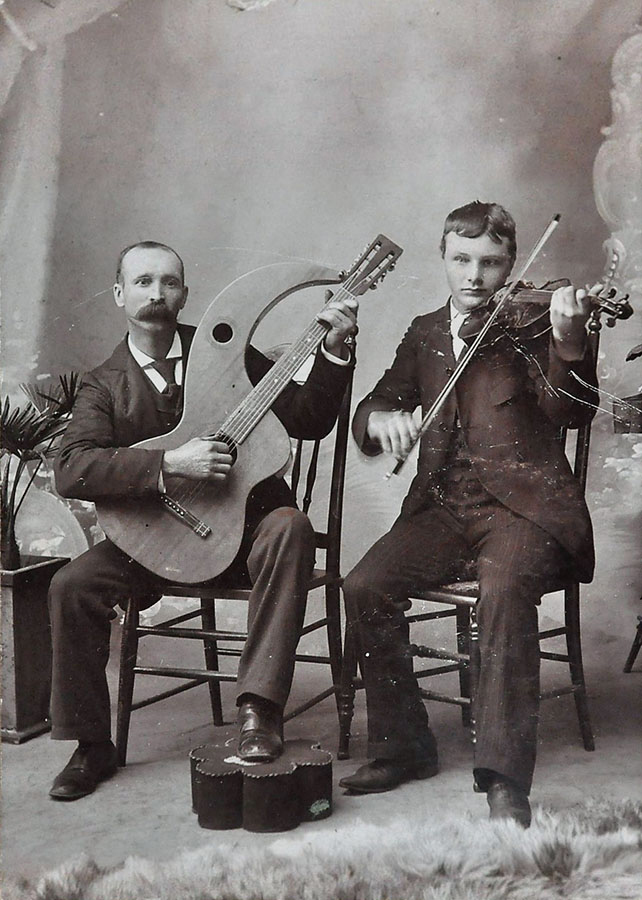 A beautiful image from eBay that I didn’t win. The gentleman plays an “1896 patent style” one-armed guitar (#HGP35).
A beautiful image from eBay that I didn’t win. The gentleman plays an “1896 patent style” one-armed guitar (#HGP35).
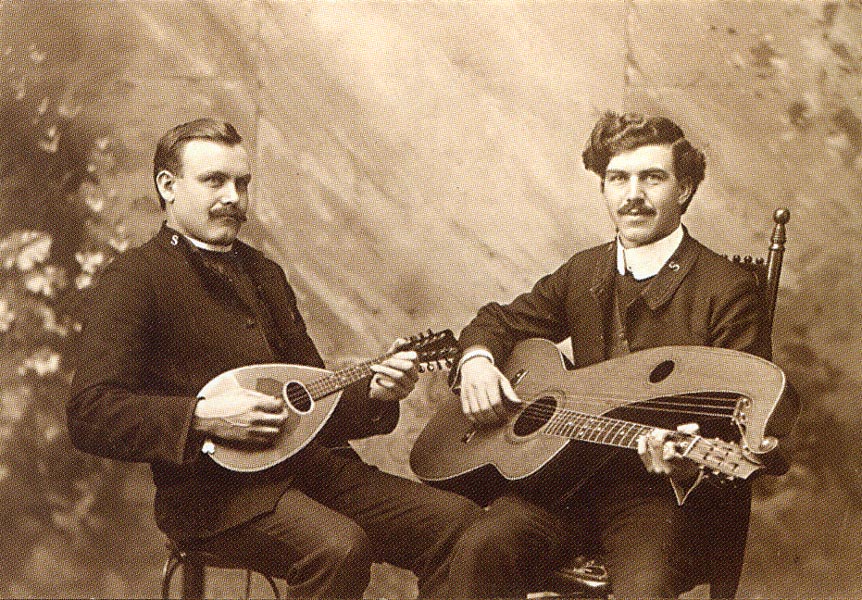
Another beautiful image, which I’ve been unable to obtain a copy of the original. This appeared in a magazine in an article from the National Cowboy Museum. The harp guitarist plays a 3-bass “1898 Patent style” instrument (#HGP34).
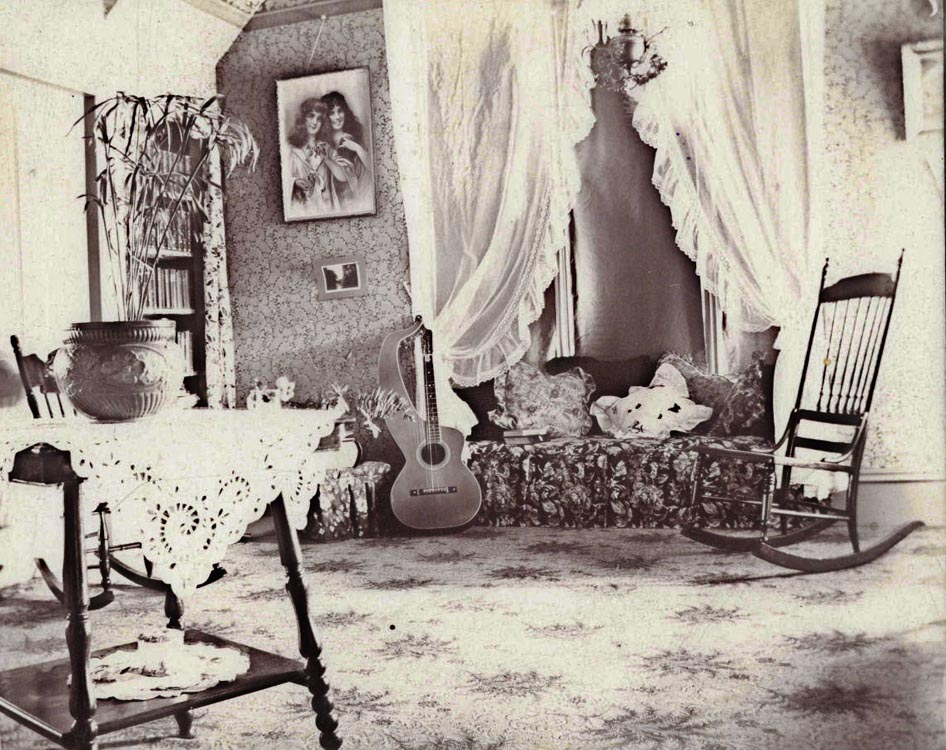
This charming c.1900 Minnesota sitting room contains a fancy 5-bass 1898 Patent style harp guitar (#HGP31). This and the next photo are by special permission of the Anoka County Historical Society. Other photos from this batch were dated “1900” which coincides perfectly with these two instruments.
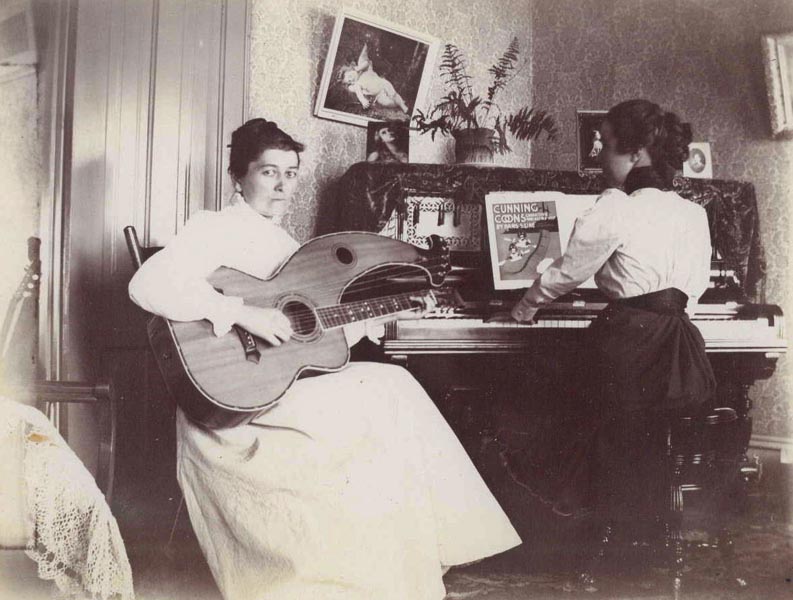 The woman playing a fancy c.1899-1900 Symphony harp guitar (#HGT61) is “Minnie Hill Beatty” – nothing has been learned about her.
The woman playing a fancy c.1899-1900 Symphony harp guitar (#HGT61) is “Minnie Hill Beatty” – nothing has been learned about her.
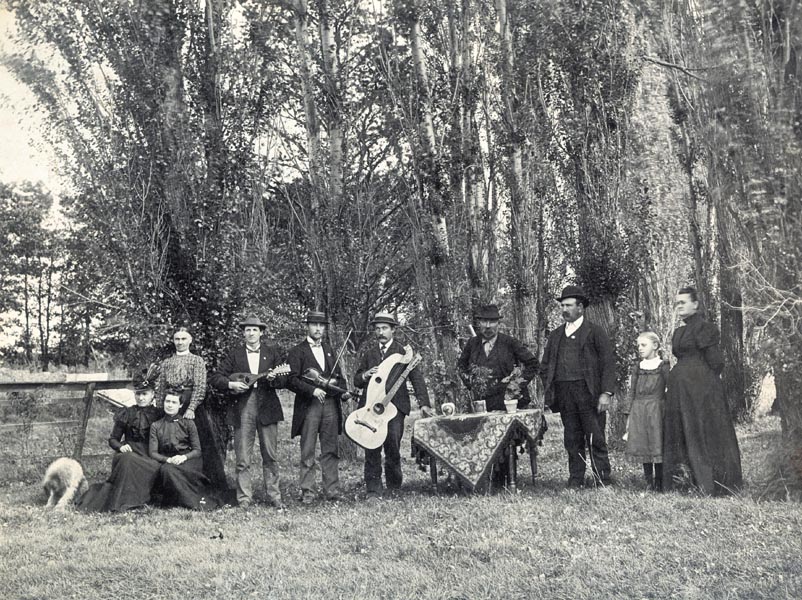
But I’m getting ahead of myself…just before the standard Symphony model appeared, Knutsen experimented with a bass head that transitioned from the impractical 1898 patent style to the logical Symphony style. For obvious reasons, I refer to it as the “elephant trunk.” This fantastic photo came from Sheldon Stephens, an antiques and stringed instrument dealer outside St. Paul, Minnesota.
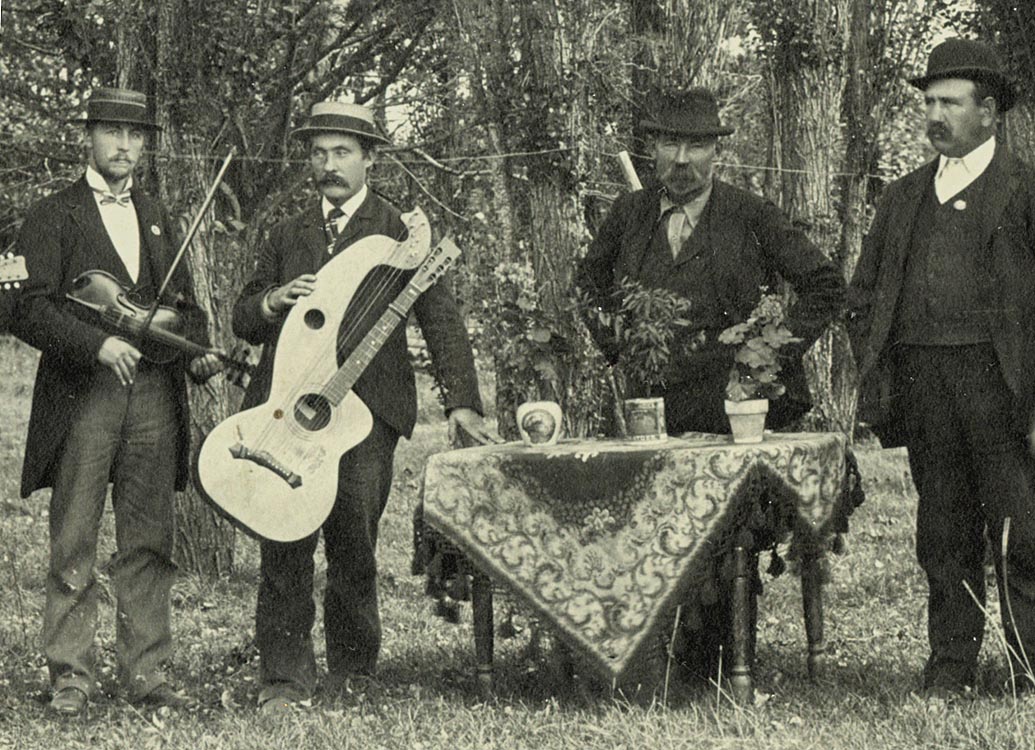 A closeup of #HGT60. Note that though I still code this pre-Symphony instrument (like all Symphonys) with a “T” for Tacoma, even though we now know that it was actually built in Port Townsend.
A closeup of #HGT60. Note that though I still code this pre-Symphony instrument (like all Symphonys) with a “T” for Tacoma, even though we now know that it was actually built in Port Townsend.
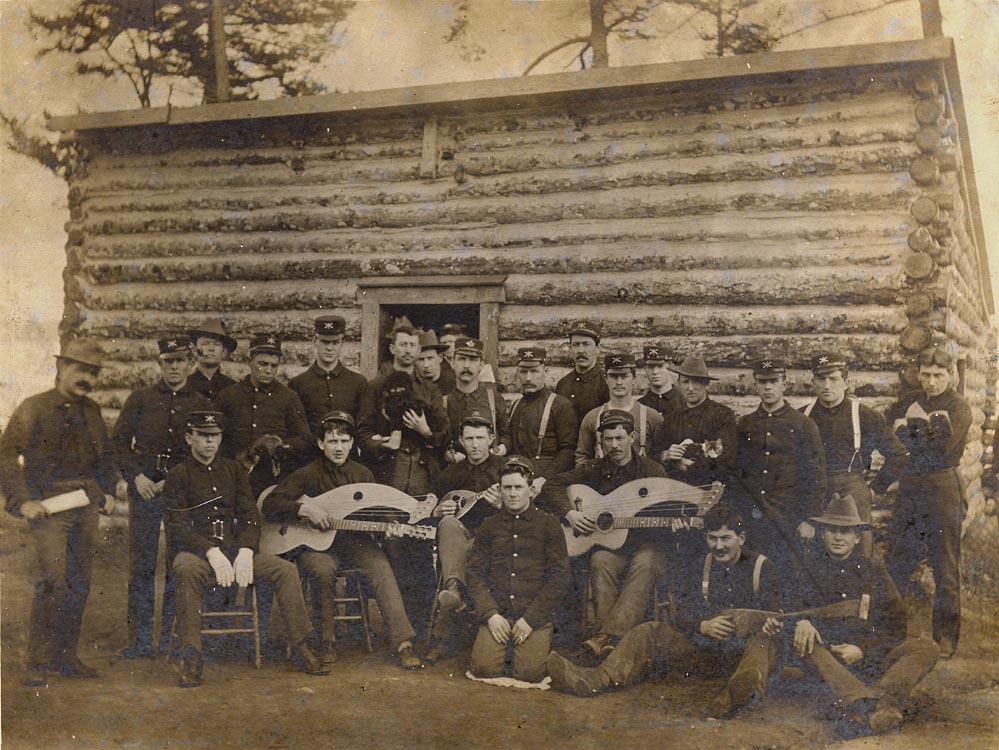 A small original photo I snagged from eBay, it shows an unknown army regiment, with two c.1900 Symphony harp guitars (and one guy playing the “oar”). With images like these, it is all but impossible to ID the instruments as distinct new specimens. If anyone can better the place/period/group by the uniforms, please let me know.
A small original photo I snagged from eBay, it shows an unknown army regiment, with two c.1900 Symphony harp guitars (and one guy playing the “oar”). With images like these, it is all but impossible to ID the instruments as distinct new specimens. If anyone can better the place/period/group by the uniforms, please let me know.
 This Symphony player is a bit gruff, but still has plenty of turn-of-the-last-century charm. From a photo owned by Neil Smith. The proportions and placement of headstock and carved tuner slots just allow me to ID #HGT58 as unique.
This Symphony player is a bit gruff, but still has plenty of turn-of-the-last-century charm. From a photo owned by Neil Smith. The proportions and placement of headstock and carved tuner slots just allow me to ID #HGT58 as unique.
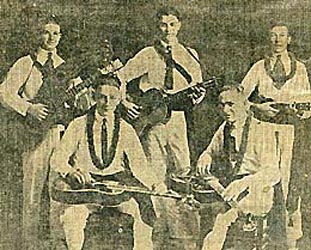
I first learned of John Lee Coppock via Knutsenologist Darrell Urbien. He had located our fellow researcher Peter Blecha’s article on Coppock here. The image above shows the Coppock Quintet c.1920, with a sideman playing a very-hard-to-discern c.1901-1902 18-string Symphony harp guitar…
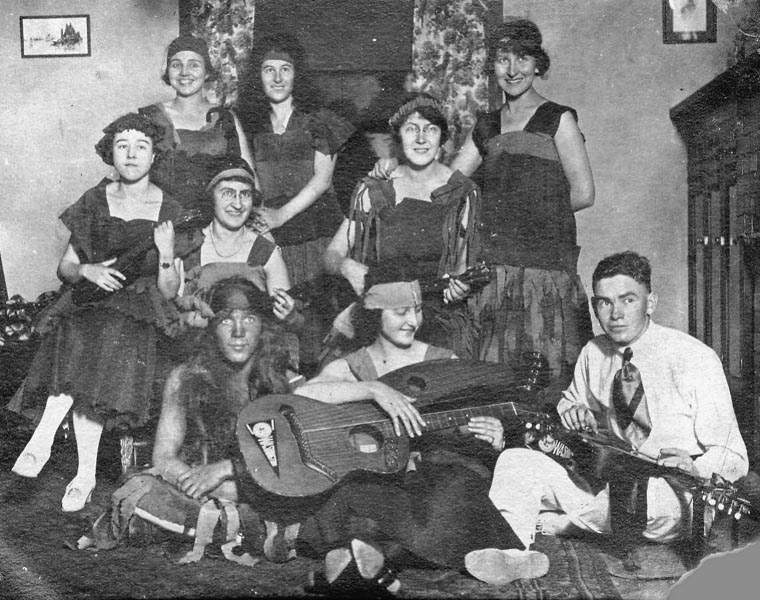
…however, Peter soon sent me another photo of Coppock with a group of college kids at Washington State College in Pullman, Washington, c.1919. It shows the instrument (#HGT62, which Peter suspects Coppock owned) much clearer.
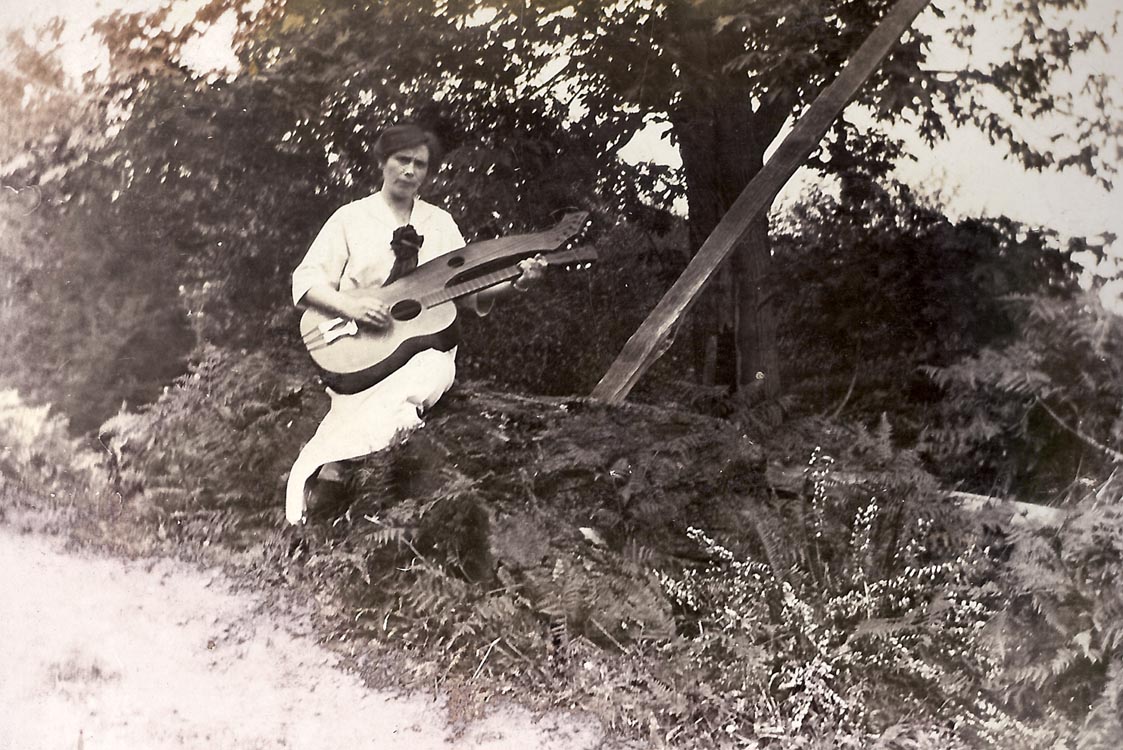 John & Jeanette Detlor (of Otto Anderson fame) shared this new image some time back: “The photo came out of a family album from the family of Otto Anderson’s son Oscar’s wife. The family has lived in the Port Angeles, Washington area for about 100 years and many of the photos in the album were taken in that area.” The unknown woman plays an unusual instrument in that the bass headstock shape represents a transition from the last of the Tacoma “Evolved Symphony” shapes to the new Seattle shapes – it is literally halfway between both. Not having the first Seattle instruments’ “lower bass point” (bottom of bass side body flare), I’ll archive this as the last of the known Tacoma specimens (#HGT71). The dual tailpieces are add-ons.
John & Jeanette Detlor (of Otto Anderson fame) shared this new image some time back: “The photo came out of a family album from the family of Otto Anderson’s son Oscar’s wife. The family has lived in the Port Angeles, Washington area for about 100 years and many of the photos in the album were taken in that area.” The unknown woman plays an unusual instrument in that the bass headstock shape represents a transition from the last of the Tacoma “Evolved Symphony” shapes to the new Seattle shapes – it is literally halfway between both. Not having the first Seattle instruments’ “lower bass point” (bottom of bass side body flare), I’ll archive this as the last of the known Tacoma specimens (#HGT71). The dual tailpieces are add-ons.
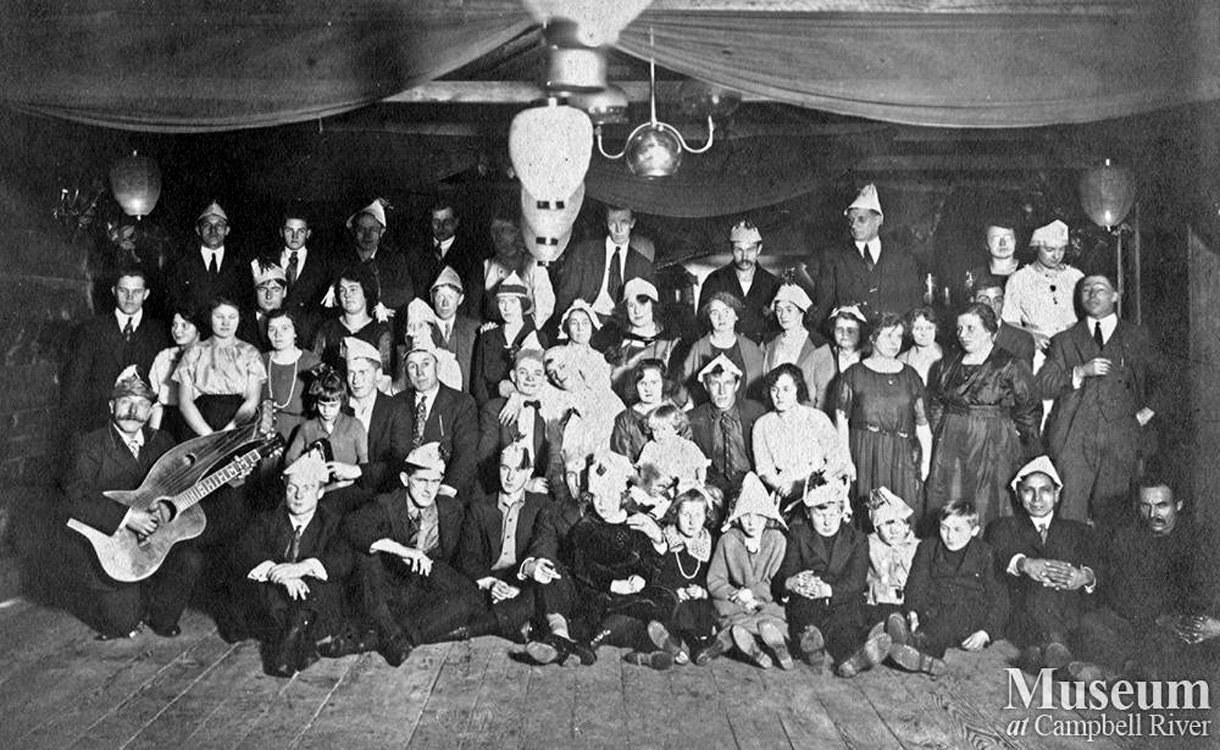 (by special permission from the Campbell River Museum)
(by special permission from the Campbell River Museum)
The above image represents an unusual case where a surviving instrument was discovered first, only to be later matched with a photo (2, actually) of the original owner: Charles “Dutchie” Neuberg, of the Brown and Kirkland logging crew at Campbell River, British Columbia. The photo dates from 1925. Dutchie’s already-altered Knutsen harp guitar, #HGS89 (note its metal plate reinforcing the bass head) was a c.1911-1913 Seattle instrument (with SE2 label, just as I had guessed), and has been further altered – and now added to the Campbell River Museum to go with the historical photos! See the story here. Curator Beth Boyce and I both had a lot of fun researching this one.
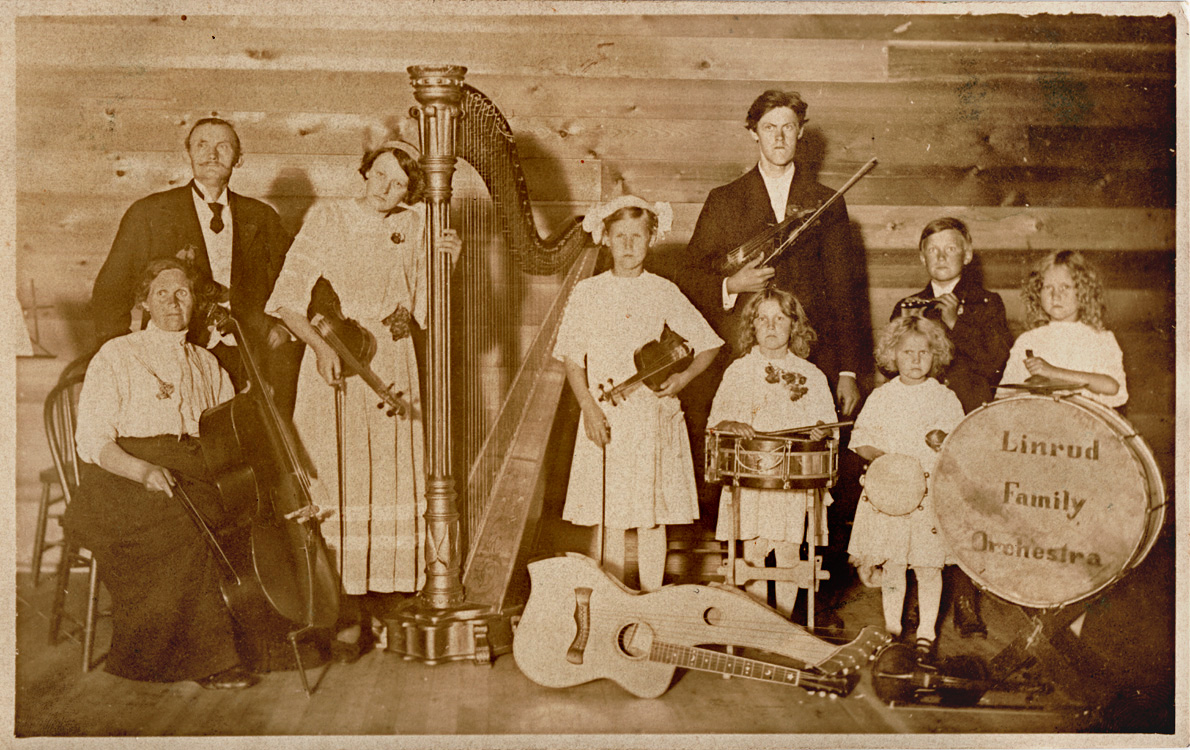 An unused postcard I got from eBay (inexpensively, for once). It is the second image of the preternaturally deadpan Linrud Family Orchestra with their Knutsen harp guitar. Long ago, I had brazenly added the instrument to the Archives as #HGS30, even though the original image showed just a hint of it in the shot. I was happy to be able to confirm it as unique, even all these years (and many more Knutsen harp guitar discoveries) later.
An unused postcard I got from eBay (inexpensively, for once). It is the second image of the preternaturally deadpan Linrud Family Orchestra with their Knutsen harp guitar. Long ago, I had brazenly added the instrument to the Archives as #HGS30, even though the original image showed just a hint of it in the shot. I was happy to be able to confirm it as unique, even all these years (and many more Knutsen harp guitar discoveries) later.
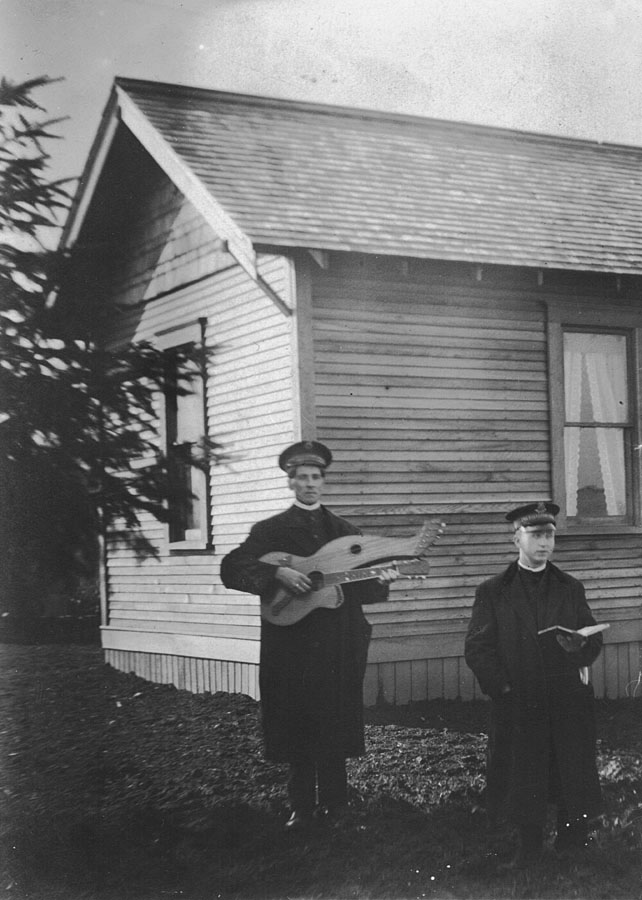 I didn’t win this fascinating Knutsen image on eBay, but the seller (Sara Boatwright) kindly sent me a high res scan. It depicts a Salvation Army member playing a 3/4 size mid-Seattle period 18-string (#HGS80).
I didn’t win this fascinating Knutsen image on eBay, but the seller (Sara Boatwright) kindly sent me a high res scan. It depicts a Salvation Army member playing a 3/4 size mid-Seattle period 18-string (#HGS80).
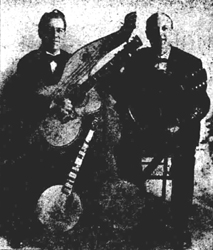 Some additional sleuthing on the invaluable Chronicling America site unearthed this Arizona Republican article from January, 1910. It is one of the few (only?) times mention was made of the builder of these instruments. You can see a c.1908 11-string Seattle harp guitar, and the headstock of what must be a harp mandolin, but what is a Knutsen “lyre“?! Oh, for a better image! The text about Messrs. Hesse and Williams states: “The instruments they play are of the finest made. The harp guitar, lyre and mandolin are a feature in themselves. They were made by the famous foreign harp maker, C. Knudsen (sic), of Seattle, formerly of Stockholm, Sweden (??? Chris was born in Norway). The harp guitar has (unreadable – looks like “10” or “19”?) strings and Mr. Williams is the only man who has the thorough knowledge of handling this mammoth instrument.”
Some additional sleuthing on the invaluable Chronicling America site unearthed this Arizona Republican article from January, 1910. It is one of the few (only?) times mention was made of the builder of these instruments. You can see a c.1908 11-string Seattle harp guitar, and the headstock of what must be a harp mandolin, but what is a Knutsen “lyre“?! Oh, for a better image! The text about Messrs. Hesse and Williams states: “The instruments they play are of the finest made. The harp guitar, lyre and mandolin are a feature in themselves. They were made by the famous foreign harp maker, C. Knudsen (sic), of Seattle, formerly of Stockholm, Sweden (??? Chris was born in Norway). The harp guitar has (unreadable – looks like “10” or “19”?) strings and Mr. Williams is the only man who has the thorough knowledge of handling this mammoth instrument.”
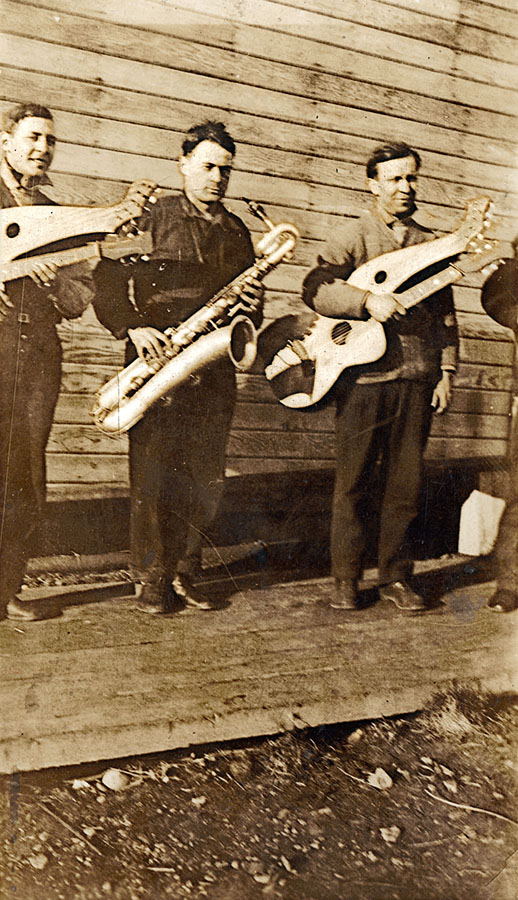 This cropped original photo gives us two Knutsen Seattle-era harp guitars along with baritone sax and who-knows-what off screen – what a combo! The left Knutsen doesn’t give us enough to identify; the one on the right becomes Inventory #HGS93.
This cropped original photo gives us two Knutsen Seattle-era harp guitars along with baritone sax and who-knows-what off screen – what a combo! The left Knutsen doesn’t give us enough to identify; the one on the right becomes Inventory #HGS93.
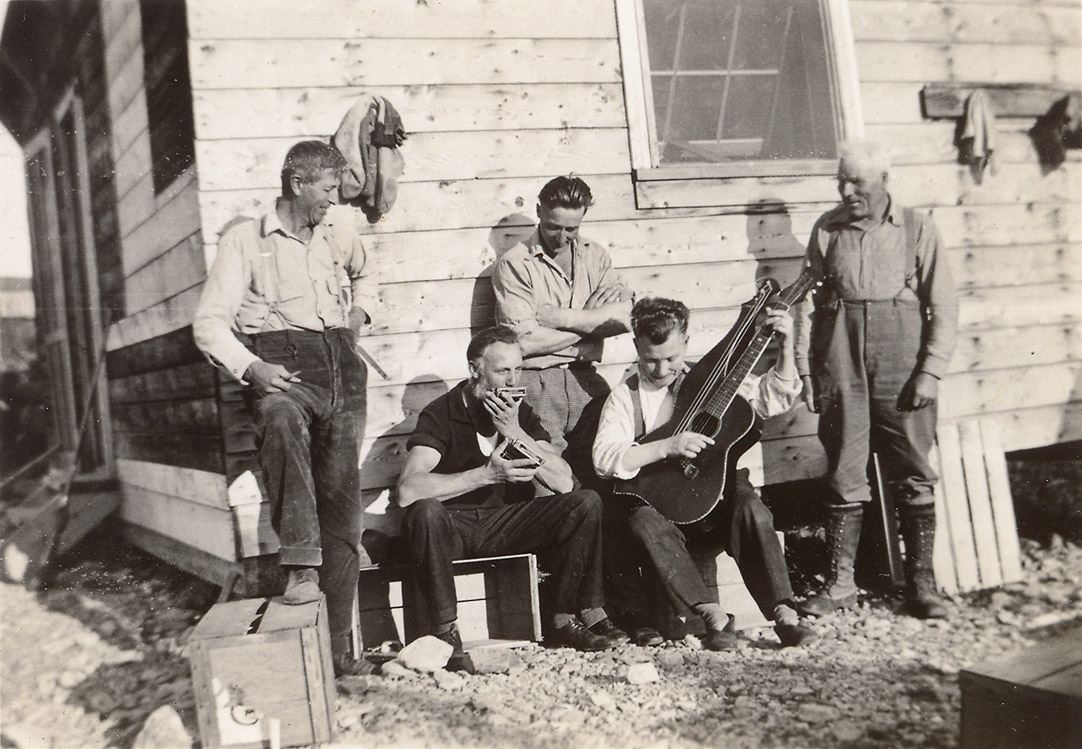 This small, but wonderful undated photo shows a casual get together with one of the men on a short arm, 3-bass black-top Knutsen (#HGS74).
This small, but wonderful undated photo shows a casual get together with one of the men on a short arm, 3-bass black-top Knutsen (#HGS74).
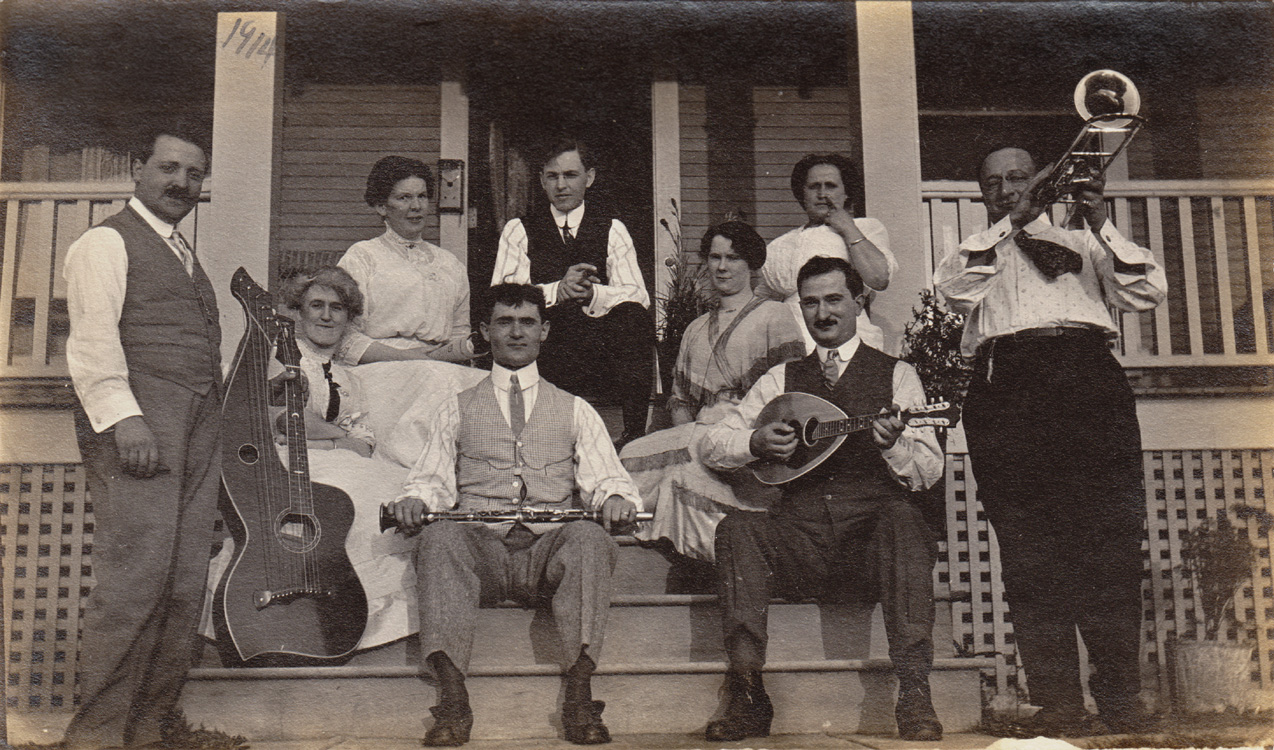 Another nice black top Knutsen that could very well be the instrument pictured on his “Harp Guitar Factory” and later “New Hawaiian Family” labels (#HGS14).
Another nice black top Knutsen that could very well be the instrument pictured on his “Harp Guitar Factory” and later “New Hawaiian Family” labels (#HGS14).
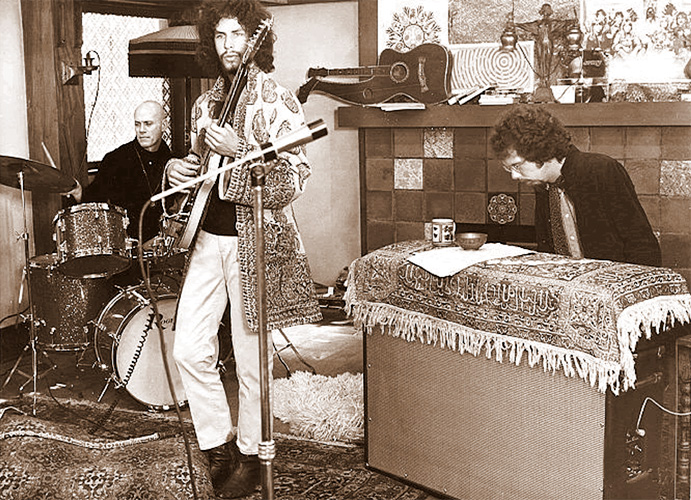 A similar c.1912 black top harp guitar (#HGS88) with more typical 5 subs on a long arm rests on the fireplace during this rehearsal of Spirit guitarist Randy California.
A similar c.1912 black top harp guitar (#HGS88) with more typical 5 subs on a long arm rests on the fireplace during this rehearsal of Spirit guitarist Randy California.
(image from www.terrascope.co.uk)
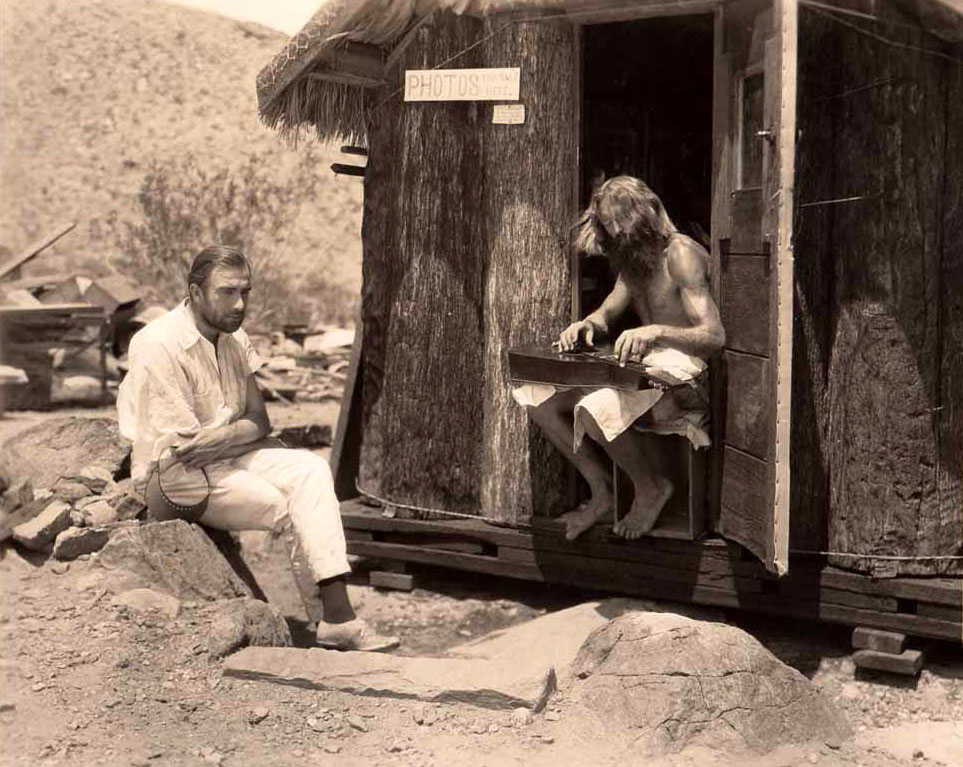 Yes, it’s our favorite “pre-Hippie-era hippie” William Pester, performing in his desert cabin for another celebrity visitor (votes?). (See more Pester shots near the end of Knutsen Historical Photos) A great shot that sold on eBay in 2010. But wait!…that’s not Pester’s normal Knutsen Weissenborn-shaped steel guitar…it looks like he had a second instrument – a Knutsen pineapple?!
Yes, it’s our favorite “pre-Hippie-era hippie” William Pester, performing in his desert cabin for another celebrity visitor (votes?). (See more Pester shots near the end of Knutsen Historical Photos) A great shot that sold on eBay in 2010. But wait!…that’s not Pester’s normal Knutsen Weissenborn-shaped steel guitar…it looks like he had a second instrument – a Knutsen pineapple?!
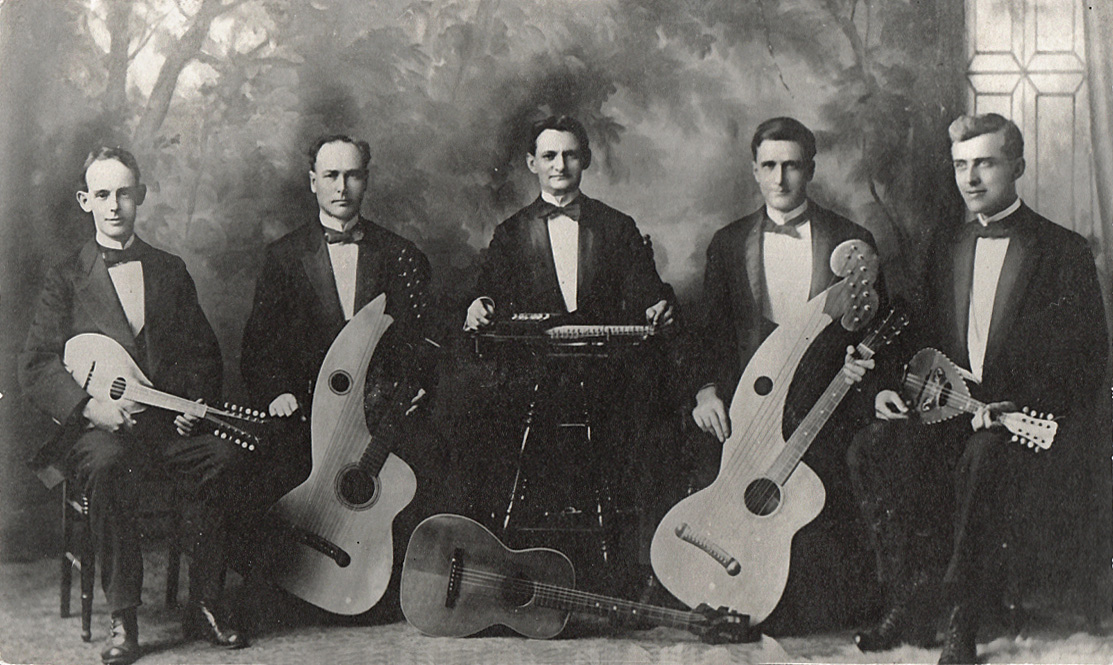 More commonly seen in historical photos is the more famous “descendent” of Knutsen’s Symphony harp guitars: the Larson brothers’ Dyer. Another eBay find I couldn’t afford.
More commonly seen in historical photos is the more famous “descendent” of Knutsen’s Symphony harp guitars: the Larson brothers’ Dyer. Another eBay find I couldn’t afford.

Every time someone inquires about a harp guitar in the family, I always ask if they have any provenance on it or any photos of their ancestors playing it. When a woman wrote about consigning her inherited early Style 7 Dyer (with the early purfling and Knutsen-signed label), I was thrilled to hear that they had a prized photo hung with it. This is her great-great uncle, playing his new (then) Dyer. She apparently changed her mind, but I hope we can offer this instrument – with accompanying print of the original owner – one day!
Another classic new Dyer player image that sold recently on eBay.

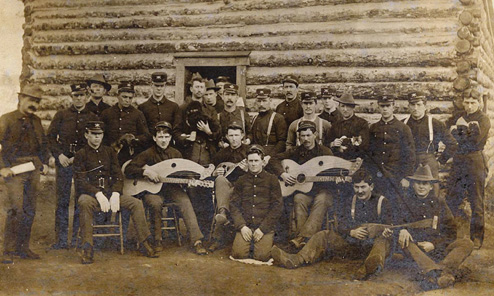
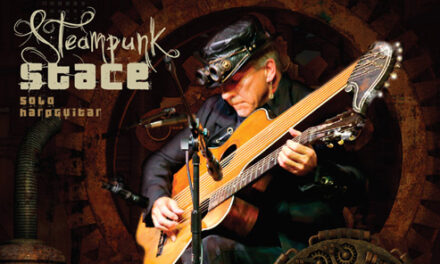
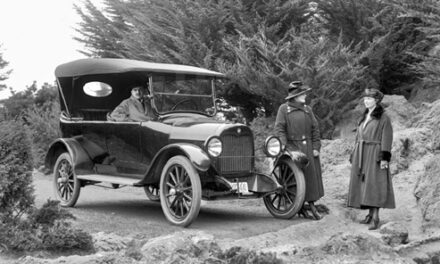
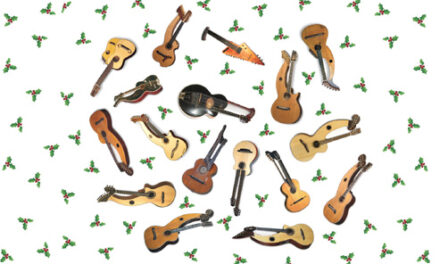
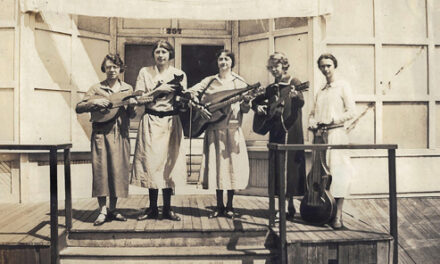
I see you have a post card of my ancestors the Linrud Orchestra on that’s really cool and thank you.
And today, I updated yet again, while posting a new blog about the additions: https://www.harpguitars.net/2014/04/a-kouple-more/
2 weeks later, I stumbled across yet another original photo I had missed in my pile (inserted above); check out the dual Knutsen harp guitarists with sax!
Thank you so much for posting these incredible pieces of art.
Oh, there’s plenty of 6-bass Gibsons in that Iconography section, Michael…and more waiting in the wings….
Fascinating and loved expanding the pics to take a closer look. I guess there are not too many 6 bass Gibson HG pics out there.
Amazing as always! Thanks Gregg!